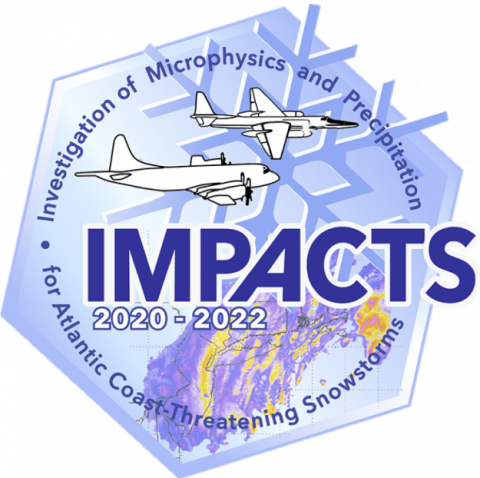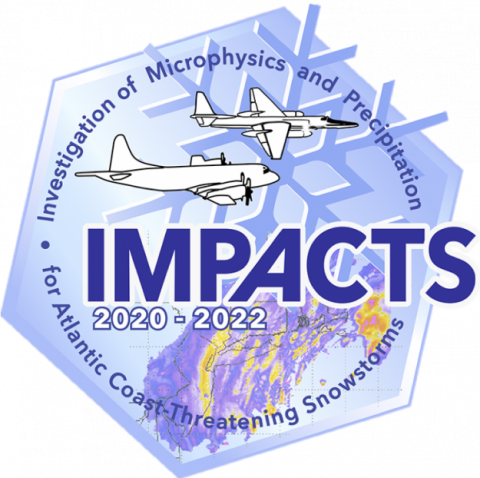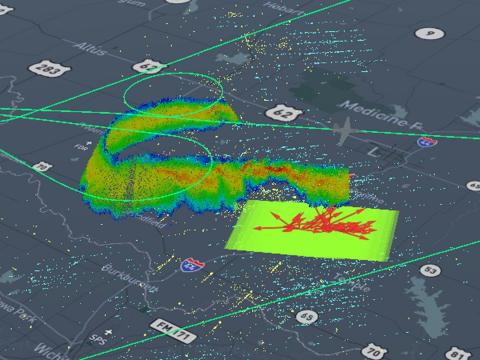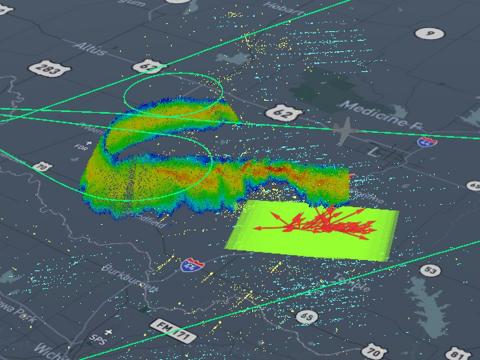 The NASA Global Hydrology Resource Center (GHRC) DAAC published the Autonomous Parsivel Unit (APU) IMPACTS dataset. These data were collected in support of the Investigation of Microphysics and Precipitation for Atlantic Coast-Threatening Snowstorms (IMPACTS) campaign. The IMPACTS field campaign addressed providing observations critical to understanding the mechanisms of snowband formation, organization, and evolution, examining how the microphysical characteristics and likely growth mechanisms of snow particles vary across snowbands, and improving snowfall remote sensing interpretation and modeling to significantly advance prediction capabilities. This dataset consists of precipitation data including precipitation amount, precipitation rate, reflectivity in Rayleigh regime, liquid water content, drop diameter, and drop concentration. Data are available in ASCII format from January 15, 2020 through February 29, 2020.
The NASA Global Hydrology Resource Center (GHRC) DAAC published the Autonomous Parsivel Unit (APU) IMPACTS dataset. These data were collected in support of the Investigation of Microphysics and Precipitation for Atlantic Coast-Threatening Snowstorms (IMPACTS) campaign. The IMPACTS field campaign addressed providing observations critical to understanding the mechanisms of snowband formation, organization, and evolution, examining how the microphysical characteristics and likely growth mechanisms of snow particles vary across snowbands, and improving snowfall remote sensing interpretation and modeling to significantly advance prediction capabilities. This dataset consists of precipitation data including precipitation amount, precipitation rate, reflectivity in Rayleigh regime, liquid water content, drop diameter, and drop concentration. Data are available in ASCII format from January 15, 2020 through February 29, 2020.GHRC News
 The NASA Global Hydrology Resource Center (GHRC) DAAC published the Autonomous Parsivel Unit (APU) IMPACTS dataset. These data were collected in support of the Investigation of Microphysics and Precipitation for Atlantic Coast-Threatening Snowstorms (IMPACTS) campaign. The IMPACTS field campaign addressed providing observations critical to understanding the mechanisms of snowband formation, organization, and evolution, examining how the microphysical characteristics and likely growth mechanisms of snow particles vary across snowbands, and improving snowfall remote sensing interpretation and modeling to significantly advance prediction capabilities. This dataset consists of precipitation data including precipitation amount, precipitation rate, reflectivity in Rayleigh regime, liquid water content, drop diameter, and drop concentration. Data are available in ASCII format from January 15, 2020 through February 29, 2020.
The NASA Global Hydrology Resource Center (GHRC) DAAC published the Autonomous Parsivel Unit (APU) IMPACTS dataset. These data were collected in support of the Investigation of Microphysics and Precipitation for Atlantic Coast-Threatening Snowstorms (IMPACTS) campaign. The IMPACTS field campaign addressed providing observations critical to understanding the mechanisms of snowband formation, organization, and evolution, examining how the microphysical characteristics and likely growth mechanisms of snow particles vary across snowbands, and improving snowfall remote sensing interpretation and modeling to significantly advance prediction capabilities. This dataset consists of precipitation data including precipitation amount, precipitation rate, reflectivity in Rayleigh regime, liquid water content, drop diameter, and drop concentration. Data are available in ASCII format from January 15, 2020 through February 29, 2020. The NASA Global Hydrology Resource Center (GHRC) DAAC published the Mission Reports IMPACTS dataset. This dataset consists of flight plans, plans of the day, science plans, and science summaries logged by scientists during the Investigation of Microphysics and Precipitation for Atlantic Coast-Threatening Snowstorms (IMPACTS) field campaign. IMPACTS was a three-year sequence of winter season deployments conducted to study snowstorms over the U.S Atlantic Coast (2020-2022). The campaign aimed to (1) Provide observations critical to understanding the mechanisms of snowband formation, organization, and evolution; (2) Examine how the microphysical characteristics and likely growth mechanisms of snow particles vary across snowbands; and (3) Improve snowfall remote sensing interpretation and modeling to significantly advance prediction capabilities. The mission reports are available from January 17 through March 1, 2020 in PDF format. It should be noted that this dataset will be updated in subsequent years of the IMPACTS campaign.
The NASA Global Hydrology Resource Center (GHRC) DAAC published the Mission Reports IMPACTS dataset. This dataset consists of flight plans, plans of the day, science plans, and science summaries logged by scientists during the Investigation of Microphysics and Precipitation for Atlantic Coast-Threatening Snowstorms (IMPACTS) field campaign. IMPACTS was a three-year sequence of winter season deployments conducted to study snowstorms over the U.S Atlantic Coast (2020-2022). The campaign aimed to (1) Provide observations critical to understanding the mechanisms of snowband formation, organization, and evolution; (2) Examine how the microphysical characteristics and likely growth mechanisms of snow particles vary across snowbands; and (3) Improve snowfall remote sensing interpretation and modeling to significantly advance prediction capabilities. The mission reports are available from January 17 through March 1, 2020 in PDF format. It should be noted that this dataset will be updated in subsequent years of the IMPACTS campaign. The NASA Global Hydrology Resource Center (GHRC) DAAC coordinated with NASA Earthdata to present the webinar, “Improving the DAAC User Experience with Cloud-based Capabilities.” The presentation took place on July 23, 2020 and is the annual webinar GHRC provides to Earthdata. The webinar focused on GHRC’s transition to a cloud-based archive. This included the reasons for the transition as well as how this transition affects users, both data providers and data users. The key part of the presentation was the live demonstration of the Field Campaign eXplorer (FCX) highlighting this system and providing a publicly accessible link (http://ghrc-fcx-app.s3-website-us-west-2.amazonaws.com/).
The NASA Global Hydrology Resource Center (GHRC) DAAC coordinated with NASA Earthdata to present the webinar, “Improving the DAAC User Experience with Cloud-based Capabilities.” The presentation took place on July 23, 2020 and is the annual webinar GHRC provides to Earthdata. The webinar focused on GHRC’s transition to a cloud-based archive. This included the reasons for the transition as well as how this transition affects users, both data providers and data users. The key part of the presentation was the live demonstration of the Field Campaign eXplorer (FCX) highlighting this system and providing a publicly accessible link (http://ghrc-fcx-app.s3-website-us-west-2.amazonaws.com/).
The webinar can be accessed via:
Direct Link: https://earthdata.adobeconnect.com/ptn39o940acq/
NASA Earthdata YouTube Link: https://youtu.be/XzOmHN2_dRE

Webinar: Improving the DAAC User Experience with Cloud-based Capabilities | Earthdata
NASA EOSDIS webinar to be held on July 23, 2020 to learn more about GHRC activities to transition the user experience to the cloud.
Come join us for our next webinar!
"This presentation will discuss NASA's Global Hydrology Resource Center Distributed Active Archive Center (GHRC DAAC) activities to transition the user experience to the cloud, how these efforts are being applied (e.g., tools, visualizations, and analysis), and how this supports users."
Thursday, July 23, 2020 at 2:00 pm EDT.
Our speaker will be Geoffrey Stano, from the GHRC DAAC.
For information or to register: https://go.nasa.gov/2Zu1BnD
 The NASA Global Hydrology Resource Center (GHRC) DAAC published the SBU Mobile Soundings IMPACTS dataset. This dataset consists of mobile sounding profiles collected during the Investigation of Microphysics and Precipitation for Atlantic Coast-Threatening Snowstorms (IMPACTS) campaign. Funded by NASA’s Earth Venture program, IMPACTS is the first comprehensive study of East Coast snowstorms in 30 years. Mobile sounding profiles were obtained about every three hours during snow events by the Stony Brook University (SBU). The sounding measures temperature, humidity, height, and horizontal wind direction and speed in the atmosphere. Atmospheric pressure is calculated from GPS height. Data files are available from January 18, 2020 through February 27, 2020 in netCDF-3 format.
The NASA Global Hydrology Resource Center (GHRC) DAAC published the SBU Mobile Soundings IMPACTS dataset. This dataset consists of mobile sounding profiles collected during the Investigation of Microphysics and Precipitation for Atlantic Coast-Threatening Snowstorms (IMPACTS) campaign. Funded by NASA’s Earth Venture program, IMPACTS is the first comprehensive study of East Coast snowstorms in 30 years. Mobile sounding profiles were obtained about every three hours during snow events by the Stony Brook University (SBU). The sounding measures temperature, humidity, height, and horizontal wind direction and speed in the atmosphere. Atmospheric pressure is calculated from GPS height. Data files are available from January 18, 2020 through February 27, 2020 in netCDF-3 format.





